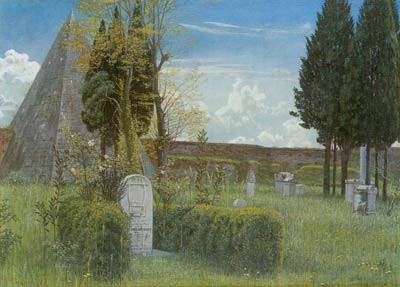From Wikipedia
One of my favourite places is the Protestant Cemetery in Rome.

Shelley’s Tomb in the Protestant Cemetery in Rome, an 1873 painting by Walter Crane. The tombstone in the foreground is actually that of John Keats; the Pyramid of Cestius is in the background.
The Protestant Cemetery (Italian: Cimitero protestante), officially called the Cimitero acattolico (“Non-Catholic Cemetery”) and often referred to as the Cimitero degli Inglesi (“English Cemetery”) is a cemetery in Rome, located near Porta San Paolo alongside the Pyramid of Cestius, a small-scale Egyptian-style pyramid built in 30 BCE as a tomb and later incorporated into the section of the Aurelian Walls that borders the cemetery. Mediterranean cypress trees and other foliage in the cemetery cause it to mirror the more natural style of cemeteries seen in the lusher regions of northern Europe. As the name of the cemetery indicates, it is the final resting place of non-Catholics (not only Protestants or English people).
The earliest known burial is that of an Oxford student named Langton in 1738. The most famous graves are those of the English poets John Keats (1795-1821) and Percy Bysshe Shelley (1792-1822). Keats died in Rome of tuberculosis. His epitaph, which does not mention him by name, is by his friends Joseph Severn and Charles Brown: “This grave contains all that was mortal, of a YOUNG ENGLISH POET, Who on his Death Bed, in the Bitterness of his Heart, at the Malicious Power of his Enemies, Desired these Words to be engraven on his Tomb Stone: Here lies One Whose Name was writ in Water.” Shelley drowned off the Italian Riviera and was cremated on the shore near Viareggio. His ashes were interred in the Protestant Cemetery; his heart, which his friend Edward John Trelawny had snatched from the flames, was kept by his widow Mary Shelley until her death and buried with her in Bournemouth.
Notable burials
* Hendrik Christian Andersen (1872-1940), sculptor, friend of Henry James
* Karl Briullov (1799-1852), Russian painter
* Zakhar Grigor’evich Chernyshev (1796-1862), Russian participant in the Decembrist revolt
* Gregory Corso (1930-2001), American beat generation poet
* Richard Henry Dana, Jr., American author of Two Years Before the Mast
* Carlo Emilio Gadda (1893-1973), Italian novelist
* August von Goethe (1789-1830), son of Johann Wolfgang von Goethe; his monument features a medallion by Bertel Thorvaldsen
* Antonio Gramsci (1891-1937), Italian philosopher, leader of the Italian Communist Party
* John Keats (1795-1821), English poet
* Richard Saltonstall Greenough (1819-1904), American sculptor
* Wilhelm von Humboldt (1794-1803), son of the German diplomat and linguist Wilhelm von Humboldt
* Alexander Ivanov (1806-1858), Russian painter
* Vyacheslav Ivanov (1866-1949), Russian poet, philosopher, and classical scholar
* Hans von Marées (1837-1887), German painter
* Malwida von Meysenbug (1816-1903), German author
* Axel Munthe (1857-1949), Swedish physician and author
* Thomas Jefferson Page (1808-1899), commander of United States Navy expeditions exploring the Rio de la Plata
* Gottfried Semper (1803-1879), German architect
* Joseph Severn (1793-1879), English painter, consul in Rome, and friend of John Keats, beside whom he is buried
* Percy Bysshe Shelley (1792-1822), English poet
* Franklyn Simmons (1839-1913), American sculptor and painter
* William Wetmore Story (1819-1895), American sculptor, buried beside his wife under his own Angel of Grief.
* John Addington Symonds (1840-1893), English poet and critic
* Lady Temple (died 1809), wife of Sir Grenville Temple, 9th Baronet
* Edward John Trelawny (1792-1881), English author, friend of Percy Bysshe Shelley, beside whose ashes he is buried
* Wilhelm Friedrich Waiblinger (1804-1830), German poet and biographer of Friedrich Halderlin
* Constance Fenimore Woolson (1840-1894) American novelist and short story writer, friend of Henry James
